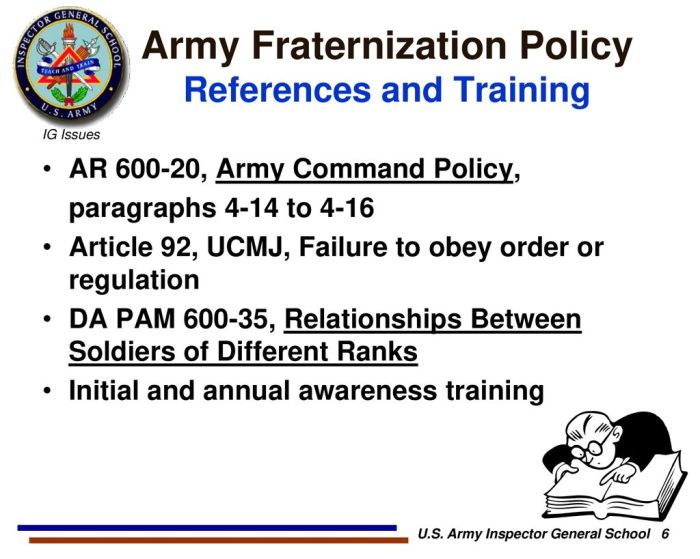Providing annual training and indoctrination on fraternization is paramount to fostering a professional and ethical workplace environment. This comprehensive guide delves into the essential elements of such training, including its purpose, content, delivery methods, and evaluation techniques, ensuring effective implementation and sustained impact.
1. Overview of Annual Training and Indoctrination on Fraternization

Annual training and indoctrination on fraternization are essential components of any comprehensive ethics and compliance program. These sessions aim to educate employees and members about the policies and regulations governing fraternization, emphasizing the importance of maintaining professional boundaries and preventing inappropriate relationships.
The primary objectives of this training are to:
- Provide a clear understanding of the definition of fraternization and its potential consequences.
- Identify prohibited relationships and situations that could lead to conflicts of interest or ethical violations.
- Establish clear reporting procedures for any suspected or actual instances of fraternization.
2. Methods and Procedures for Training and Indoctrination

The training can be delivered through various methods, including:
- In-person sessions: These allow for direct interaction between trainers and participants, enabling discussions and real-time clarification of any queries.
- Online modules: Self-paced online modules provide flexibility and convenience for participants, allowing them to complete the training at their own time and pace.
- Blended approach: A combination of in-person sessions and online modules can provide a comprehensive and engaging learning experience.
The frequency and duration of the training may vary depending on the organization’s size, industry, and risk profile. It is typically conducted annually or more frequently as deemed necessary.
3. Content and Structure of the Training: Providing Annual Training And Indoctrination On Fraternization
The training content is typically organized into logical modules or sections, each covering a specific aspect of fraternization.
An effective training Artikel may include the following modules:
- Module 1: Definition and Scope of Fraternization
- Key definitions and concepts
- Types of fraternization
- Potential consequences of inappropriate relationships
- Module 2: Prohibited Relationships
- Relationships with subordinates or superiors
- Relationships with clients or vendors
- Relationships with competitors
- Module 3: Reporting Procedures
- How to report suspected or actual fraternization
- Confidentiality and protection for whistleblowers
- Consequences of failing to report
4. Evaluation and Assessment of Training Effectiveness

Evaluating the effectiveness of the training is crucial to ensure that it is meeting its intended objectives.
Methods for evaluating training effectiveness include:
- Surveys:Collecting feedback from participants through surveys to assess their understanding of the material and their satisfaction with the training.
- Feedback forms:Gathering written feedback from participants to identify areas for improvement and address any concerns.
- Assessments:Conducting assessments, such as quizzes or case studies, to measure participants’ knowledge and ability to apply the principles learned in the training.
Based on the evaluation results, recommendations for improving the training can be made to enhance its impact and effectiveness.
5. Resources and Support for Participants

Providing ongoing support and resources to participants is essential to reinforce the training and promote ethical behavior.
Resources and support may include:
- Online forums:Establishing online platforms where participants can connect with each other, ask questions, and share experiences.
- Mentorship programs:Pairing participants with experienced mentors who can provide guidance and support.
- Confidential reporting channels:Maintaining anonymous reporting channels for participants to report any concerns or suspected violations.
Designating specific individuals or teams to provide ongoing support and guidance ensures that participants have access to the necessary resources and assistance.
FAQ Explained
What is the primary objective of fraternization training?
To educate employees on the definition and consequences of fraternization, prohibited relationships, and reporting procedures, promoting ethical behavior and mitigating workplace risks.
How often should fraternization training be conducted?
Annually, or more frequently as deemed necessary based on organizational risk assessments and industry best practices.
What are the key elements of effective fraternization training content?
Clear definitions, real-world examples, interactive exercises, case studies, and opportunities for discussion and Q&A.